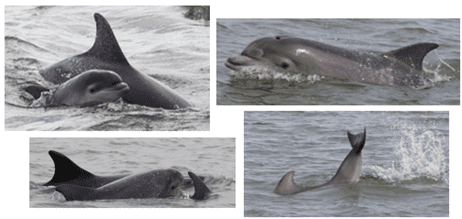Kirsten Wohak – Shannon Dolphin Project Intern 2022
The work varied so much that I never got bored
I am Kirsten Wohak and I was given the opportunity to intern at the Shannon Dolphin Project in Kilrush for the past 6 weeks. In my case, this was not a given as my background is in math. I studied math and physics in Germany as part of a teaching degree followed by a PhD.
I learned to dive between my first masters and PhD. I have always had an interest in marine biology and diving only intensified my interest. So, after successfully completing my PhD, I started an international master’s in marine biology (IMBRSea) and the Shannon Dolphin Project was kind enough to give me the opportunity to gain more hands-on experience between two of my semesters.

Kirsten at Loop Head, Co. Clare doing a headland watch for bottlenose dolphins.
I have to say that I enjoyed the internship a lot and also learned an enormous amount. The work varied so much that I never got bored. I was involved in all areas and, thanks to the help of other interns who had already been part of the project for a while and my supervisors, I was quickly able to complete all tasks independently and contribute to the project.
In total, I would say I had four tasks during my internship:
The most exciting tasks for me were boat surveys. We went out onto the Shannon Estuary either on a tourist boat (Dolphin Discovery) or on our IWDG’s rib. Once on the water we looked for the dolphins. Upon encounter the goal was to get as many pictures as possible of all the dolphins we could. Especially pictures of the dorsal fin. Photographing the dorsal fins were important because we used those to identify everyone in the sighting. 
It was especially interesting to observe that they all have their own individual quirks, jags, and scars due to quarrels with other dolphins. In the beginning I had difficulties taking pictures due to several reasons: my pictures only showed water, they were blurry or didn’t have the right exposure. However, I had a very steep learning curve and after a few tries and tips from my colleagues, I quickly got the hang of it capturing beautiful pictures of dolphins and perfecting a valuable field skill I will be able to use throughout my future career in marine biology.
In addition to the time on the boat, we also went on land watches. The goal during those was to see not only dolphins, but any cetacean. For this we went to either Loop Head or Donegal Point in County Clare.
Both places are on the west coast of Ireland, so we had a perfect view of the sea and at Loop Head we could also see the mouth of the Shannon Estuary. Equipped with binoculars, telescopes, and cameras, we made ourselves comfortable for 2-3 hours and took turns scanning the horizon with the telescope. During these ‘effort watches’ we kept ourselves busy looking at the sea through binoculars or with the naked eye to not miss close individuals.
Thankfully, I didn’t have to wait long and saw groups of dolphins and also the blows of whales, which probably belonged to a humpback whale.
The task that gave me the most expertise was working at the newly rejuvenated Shannon Dolphin Center. Here we informed visitors about the residential population of bottlenose dolphins living in the estuary and educated them about whales that can be encountered in Irish waters.
There are so many facts about these creatures and yet at the same time we know so little. Through tours I gave, I became more and more confident with the details and now have much more background knowledge in cetacean ecology and identification than before.
Finally, I helped in the research (photo-id and matching of dolphins) that the project does. Matching photos to those in the catalogue involve looking at each photo taken during the 2022 field season and identifying individual dolphins by comparing our photos to those taken from previous years.
The catalogues contain a picture of the left and right side of all the encountered individuals in that year and allows you to look through all fins, it is especially fun when having a picture of a dolphin that is still unidentified and finally matching and identifying it to old pictures.
Since wounds can heal, or pigmentation can change, the characteristics of the dorsal fins of the dolphins can vary greatly over the years. Even though the work was exhausting and tedious, I learned to identify many of the dorsal fins by just looking at them and thus built up a kind of connection to the dolphins. Every time I see 200, 313, and 886 I have to smile.
In addition to these main tasks, we were able to express interest and participate in other activities of the Irish Whale and Dolphin Group and explore topics that were previously foreign to us.
For example, I got to participate in the IWDG stranding scheme and help with a postmortem. I got to examine the body looking for possible causes to explain why it might have stranded and took additional samples to see if there were any unusual readings, conditions, or injuries. In the case of our individual, nothing could be determined at first glance apart from the fact that he was severely malnourished, which interesting I learned was unlikely the cause of its stranding. The experience was very rewarding for me and showed me one of the many ways I could direct my career in the future. 
I want to thank the entire team for giving me this opportunity and being so welcoming. I learned a lot and am 100% sure that I will profit from this experience in my future

